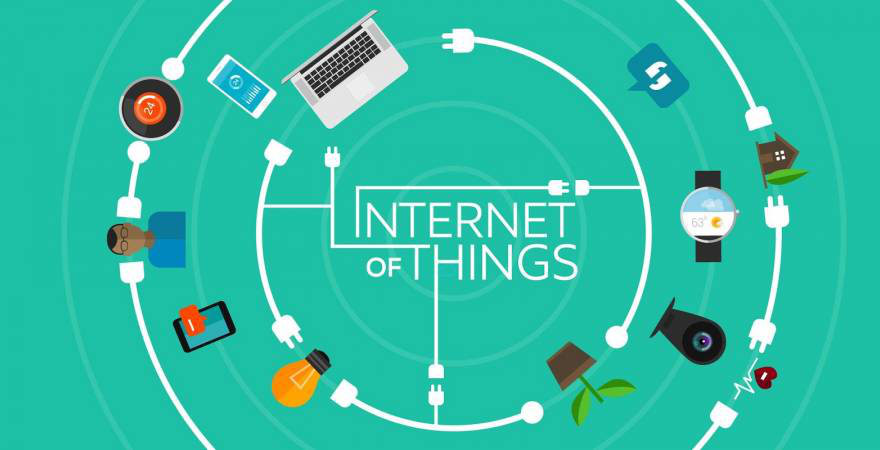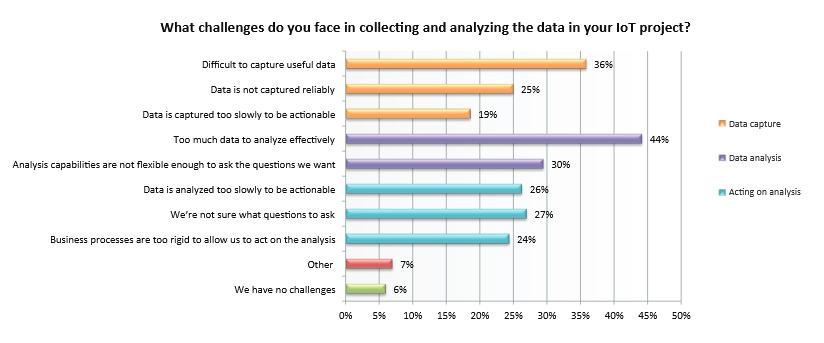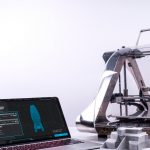Top 10 Challenges Enterprises Face in IoT Implementation

In the technological corners, finding out how quickly a newly coined term becomes a buzzword is always amusing. And in no time, it passes through different stages of development, and a handy product or service is made available for consumers.
However, a term has silently revolutionized industries without the fanfare of buzzword status: the Internet of Things (IoT). Coined by Kevin Ashton in 1999, the IoT gradually carved its path from the industrial sector to the consumer market, reshaping how we interact with technology.
It emerged gradually, fueled by remarkable advancements in sensor technology and network infrastructure. The world became “connected,” empowering businesses to unlock valuable insights and deliver exceptional services while optimizing operational costs.
Despite the availability of resources and advancements in crucial IoT components: Sensors, and Networks, many companies have not been able to benefit substantially from their IoT project.
A recent revelation by IoT Now that 50% of the assessed IoT projects were merely pilots or trials, serving as proof of concept (PoC) projects. Additionally, an additional 35% were classified as stage one early deployments. This finding aligns with the fact that most project failures occur during the early deployment stages.
When it comes to IoT implementation, effective collaboration, and integration among all the components of IoT, along with creating a culture of technology within the organization, are required to succeed.
But in doing so, many companies face critical challenges in IoT implementation related to security network investment and data analysis.
Here is a list of the 10 biggest IoT challenges enterprises face that cause quality issues, leading to project failure and budget overruns. We discuss them at length here.
Ensuring Compatibility and Interoperability
One of the most significant IoT implementation challenges enterprises face is ensuring compatibility and interoperability. Let’s dive deeper into this challenge and explore its implications.
- Quest for Compatibility
Enterprises encounter challenges in implementing IoT due to the lack of compatibility between different IoT devices, platforms, and systems. This incompatibility hampers the seamless integration of IoT solutions and poses obstacles in managing and leveraging the data generated by IoT devices effectively.
- Fragmented IoT Ecosystem
The global IoT market is expected to reach $1.3 trillion by 2026, as stated in a study by MarketsandMarkets. This highlights the need for seamless integration of a wide range of devices and systems. However, the IoT landscape is fragmented, with various vendors, OEMs, and service providers offering proprietary technologies and protocols. This fragmentation presents a substantial challenge to achieving compatibility and interoperability among the components.
- Sensor and Networking Challenges
Sensors and networking are integral components of IoT systems. However, not all machines and devices have advanced sensors and networking capabilities. Legacy machines may lack the necessary power consumption capabilities and security standards for seamless integration. This diversity in sensor technology and networking infrastructure adds complexity to achieving compatibility and interoperability. To navigate these challenges, a deep dive into the types of sensors in IoT reveals the array of options available, each playing a unique role in bridging the gap between old and new technologies.
- Impact on Data Sharing and Communication
The lack of compatibility and interoperability can hinder effective data sharing and communication between devices and systems. It may result in data silos, where valuable insights are trapped within specific platforms or devices, limiting the ability to derive meaningful and holistic conclusions.
Achieving and Sustaining Profitability
Addressing the complexities of measuring return on investment (ROI) in IoT initiatives calls for innovative solutions. A staggering 90% of executives grapple with accurately quantifying the impact of their IoT endeavors, leaving them uncertain about the value it brings to their organizations.
While ROI is commonly defined as the ratio of profit to investment cost, calculating it accurately remains a significant hurdle for leaders. To surmount this obstacle, executives must embark on their digitalization and IoT journey with a clear business goal in mind. Falling in love with the technology itself without considering the actual business value it offers is a pitfall to avoid. To truly comprehend the value of digital initiatives, executives must reframe their approach to an ROI calculation.
Instead of seeking the ROI of a specific IoT solution, the focus should shift to determining how IoT can be leveraged to address business problems and create lasting impacts. By defining the business goal of an initiative with utmost precision, executives can effectively measure its potential payoff in the future. The ROI of an IoT initiative is contingent upon how well the solution resolves the identified business problem.
Consequently, when allocating investment budgets, it is imperative to consider the technical costs and expenses associated with change management, process and tool adaptation, and skill development. Considering all these factors will reveal the true return on investment (ROI).
Embedding Cyber Security
Connecting the operational technology (OT) and information technology (IT) worlds introduces a new set of cyber challenges. As connections’ number, diversity, and complexity amplify, ensuring secure links with the cloud, industrial control centers, and third-party providers becomes crucial. We must maintain the constant availability and connectivity of our assets. Bridging the gap between OT and IT networks presents further challenges that demand attention.
In a recent HBR study, nearly half of the respondents ranked cybersecurity as an issue requiring close attention, with over one-third considering it a top concern.
So, how can entrepreneurs and business leaders looking to implement IoT overcome these challenges and fortify their digital ecosystems?
Step one is to recognize that even if your company has robust cybersecurity defenses, they likely focus primarily on protecting the IT world. However, new vulnerabilities arise in the IoT and OT landscapes, requiring an adaptive approach. Neglecting the operational technology network is a common pitfall that exposes companies to additional risks. These risks must be mitigated.
During the planning phase of your IoT projects, prioritize embedding security from the start. Conduct a comprehensive IoT risk assessment while your projects are still in development. This risk-based approach allows you to prioritize vulnerabilities and threats effectively. Prevention is critical, making it difficult for adversaries to breach your systems. However, swift detection is crucial if a cybercriminal finds a way in.
Especially in the IoT environment, a risk-driven strategy is essential. Establish transparency over your assets, ensuring your cybersecurity department knows, manages, and tracks all endpoints and devices throughout their lifecycle. Identify weaknesses and implement effective threat-monitoring solutions. Embrace innovative principles like “zero trust,” where every actor in the network and every data stream undergo strict control and verification. This helps prevent disruptions before they occur.
Looking to Build or Implement
IoT Applications?
Tackling Unstructured Data
Growing connected devices will increase the challenges of handling unstructured data on volume, velocity, and various parameters. However, the real challenge for organizations is determining which data is valuable, as only quality data is actionable.
80% of data today is unstructured, so the data cannot be stored in SQL format. The unstructured data is stored in NoSQL format, which makes its retrieval complex.
With the launch of big data frameworks such as Hadoop and Cassandra, the problem and complexity of handling unstructured data have somewhat reduced. Still, today’s data volumes are enormous, and combining them with IoT poses a significant challenge. Besides, there are no standard guidelines for the retention and use of data and metadata.
Harnessing each data source
The purpose of capturing data is to transform the information collected from various sources in a standard format that can be analyzed and automated.
According to the Hubspot report, sponsored by ParStream, out of 86% of business stakeholders who claim that data is integral to their IoT project, only 8% can capture and analyze IoT data consistently.
As IoT is mainly about dependence on sensors for signals and networks for distribution, due to certain anomalies in runtime, such as a shutdown of power, incorrect data may get recorded.
Intelligent Analytics
At this stage, we are at the very purpose of IoT i.e., translating data into meaningful information. A data or model flaw could lead to false positives and negatives. It’s crucial to recognize that raw data alone does not provide insights; it’s the art of asking the right questions that unlocks true insights.
Based on this report by Hubspot, it is apparent that 44% of IoT stakeholders face difficulty in capturing data and 30% confirm that their analytics capabilities are not strong and flexible.

Image Source: Dimenional Research
Legacy systems such as traditional analytics software, where not all data can be loaded at once, can limit the capabilities to manage real-time data and thus defeat the whole purpose of building IoT systems. Here’s what can deter intelligent analytics with IoT:
- Unpredictable action of the machine/device during an incident
- Sticking to traditional analytics software
- Slow adoption of the latest technology due to the high cost
- Lack of skilled professionals in data mining, algorithms, machine learning, and complex event processing
Beating Skepticism
While the Internet of Things (IoT) has been rapidly permeating enterprise landscapes, there remains a significant lack of understanding and skepticism surrounding this transformative technology. According to a survey by Metova, a mere one in four individuals grasps the true essence of IoT.
These challenges of IoT devices have resulted in a slower adoption rate as there are still concerns about investment, data privacy, and security risks associated with machines. Overcoming this fear is essential for widespread IoT adoption.
The solution lies in raising awareness and dispelling misconceptions. IoT solution providers should proactively educate individuals and enterprises about IoT devices’ remarkable benefits. Staying informed about the latest IoT trends can help highlight the transformative potential of these technologies and encourage wider adoption.
Individuals must conduct their research, separating fact from fiction and forming informed opinions. We can address skepticism and encourage greater acceptance by fostering a deeper understanding of IoT.
Maintaining and Managing Assets
The convergence of IoT with manufacturing holds immense potential for optimizing asset monitoring, resource management, and maintenance in ways never seen before. By seamlessly connecting assets to digital environments and leveraging data analytics, IoT becomes the driving force behind proactive maintenance strategies, preventing disruptive production downtimes and ensuring smooth supply chain operations.
Nevertheless, a fundamental question arises: how can the connection between operational technology (OT) and information technology (IT) be effectively established, particularly for aging and proprietary manufacturing assets? This is often considered the major IoT implementation challenge, shattering the illusion of relying solely on greenfield sites that are rarely feasible in reality.
Such complexities give rise to skepticism among business leaders regarding the true business potential of IoT. Moreover, as the IoT ecosystem expands, the proliferation of connected devices increases asset diversity, volume, and complexity. Managing multiple IoT technologies concurrently poses additional challenges.
Real-time asset localization emerges as another intricate obstacle. While IoT implementation strives to connect more assets, ensuring accurate real-time localization presents its own challenges.
So to overcome these hurdles, collaboration is paramount in conquering asset management challenges. You can create a co-creation environment that combines industry expertise and technical know-how through strategic partnerships with ecosystem players. One way to successfully navigate this challenge is by joining hands with professional IoT application development services.
Ensuring seamless Connectivity
Incidentally, the internet is still not available everywhere at the same speed. A global mobile satellite company, Inmarsat, research revealed that 24% of respondents find poor connectivity as one of the biggest challenges in IoT deployment.
Specifically, logistics and oil and gas companies engaged in remote operations require robust communication networks to collect data in challenging conditions and transmit it back to the center for analysis.
The quality of signals collected by the sensors and transmitted to the networks largely depends upon the routers, LAN, MAN, and WAN. These networks must be well-connected through different technologies to facilitate quick and quality communication. But the number of connected devices is growing much faster than the network coverage, which creates monitoring and tracking problems.
Providing an uninterrupted Operating Environment
The operating environment becomes a paramount concern, defining the very essence of device functionality. However, many obstacles arise depending on the deployment locality and region, hindering the seamless operation of IoT devices.
Extreme temperatures, rough handling, wind-induced wear and tear, and bustling pedestrian activities introduce uptime issues and hamper device performance. Moreover, the risks of device theft and data transmission delays further exacerbate the operating environment challenges.
The final verdict
As the IoT is all about “connected things”, the IoT projects also require a high level of assistance. The potential economic impact of IoT is immense and continuously expanding. Mckinsey’s projections suggest that by 2030, the global value enabled by IoT could range from $5.5 trillion to $12.6 trillion, encompassing the value derived by consumers and customers through IoT products and services.
To establish your presence while avoiding all the most significant IoT challenges and issues, connect with an experienced enterprise app development company. By joining hands with experts who specialize in crafting robust IoT solutions, you can navigate and triumph over the challenges, ultimately unlocking the true potential of IoT technology.
Nevertheless, keep a scope for enhancements of product capabilities to successfully improve the functional efficiency of the product or service based on the latest technology.
Finoit Technologies is a renowned mobile application development agency providing custom software development services and IOT development services. We have developed over 450 mobile apps, and have assisted many solopreneurs in their journey of startups by functioning as a tech partner and rolling out their product ideas. For questions/queries, you may write to us at info@finoit.com
Need Help with
IoT Implementation?

